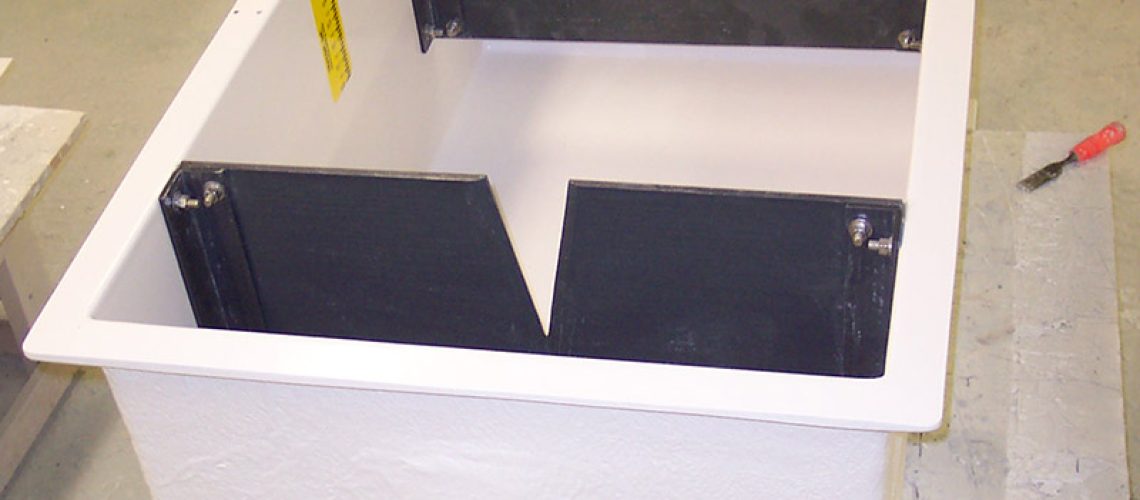Weir boxes are one of the most popular solutions for flow measurement needs. They function by incorporating a weir plate to measure flow while the box keeps the overall channel controlled with the proper conditions. Typically, they’re used to measure flows that range anywhere from 10 to 500 gallons per minute (gpm). That’s just the beginning, however, as there’s much more that goes into these systems. Here’s everything you need to know about weir boxes.
Weir Box Basics
The basics of the weir box are fairly straightforward. Put simply, it’s a device that uses a weir plate to measure the rate of flow in a channel. It typically functions best for flows between 10 gpm and 500 gpm, offering precise accuracy. Anything outside that range, however, and accuracy is often diminished fairly quickly.
Understanding the limitations of weir boxes is to know whether they’re even applicable to your flow conditions. If your flow is outside of 10 gpm to 500 gpm, you may have better luck with a flume rather than a weir box.
Remember, if the flow is lower than 10 gpm, you’re not going to get very precise readings. If it’s greater than 500 gpm, the size requirements for the box will get too large for practical use, and not following the size requirements leads to inaccurate measurements at best. You may be able to get away with greater rates by using a lot of flow conditioning methods, but that doesn’t work in all conditions.
When to Use a Weir Box
There are several instances in which it’s best to implement a weir box to get the flow rate measurement you’re looking for. The most common is when a flow has a lot of solids that need to be captured. Dam seepage would be a suitable example. Similarly, weir boxes are commonly used when a flume wouldn’t be appropriate, such as in instances without friendly upstream conditions.
Weir boxes are also suitable for implementation in complex piping structures. Whether you have multiple pipes coming in or out, a weir box is useful for keeping that kind of scenario organized and offering accurate flow rate measurements. Additionally, weir boxes are used in situations in which the flow stream needs to be specifically controlled or separated after being measured.
How Weir Boxes Condition Flow
While weir boxes are suitable for channels with unfriendly upstream conditions, the flow itself still needs to be managed in order to get accurate measurements. Fortunately, flow conditioning with a weir box is relatively easy. This is thanks to the easy implementation of a baffle or set of baffles. A baffle is essentially an obstruction designed to reduce the flow rate velocity, ensuring that it’s at a subcritical state upon approach. Sometimes there are multiple baffles, while other instances utilize perforated baffles.
How Weir Boxes Measure Flow Rate
Weir boxes differ quite a bit from their flume counterparts when it comes to actual measurement. This is because the measurement itself occurs upstream of the weir plate rather than at the plate itself. This position is typically three to five times the anticipated maximum head. Just keep in mind that the zero elevation needs to be established beforehand, as flow measurements don’t begin at the weir box’s floor. Low flows are particularly tricky to measure using traditional means, but V-notch weirs are adept at measuring such flows, provided the flow doesn’t fall below 3.99 gpm. Even so, you’ll still have to use a 22½-degree V-notch weir for proper measurement. Just make sure your equations are properly adjusted for the unique setup for low flows, and you can enjoy accurate measurements with ease.
Weir Types for Flow Management
Not all weirs are created equal. Their functionality largely depends on what kind of weir plate you opt for. They can all get the job done, but each is better suited for a different kind of flow. The most important difference to keep in mind when finding the best fit is the shape of the crest. All crests need to be pretty sharp and centered, but there can be other fluctuations.
V-Notch
One of the most common types of weirs is the V-Notch, also known as a triangular weir. It’s so popular because it works well with low flows, which are common. Flows of less than 1 cubic foot per second are best suited for V-Notch types, but these triangular weirs can also measure flows of up to 10 cubic feet per second. Additionally, the available notch angles range from 20 degrees to 120 degrees, leaving room for flexibility.
Rectangular
Rectangular weirs can come in two forms. They can either be contracted or suppressed. Contracted weirs are used primarily for higher flows with a complex discharge equation. A suppressed weir is largely the same, but it’s more flexible in terms of installation, as the discharge equation is much simpler. The downside of a suppressed weir is that you have to properly aerate the nappe for accurate measurements.
Proportional
Most weirs have to account for the changes among a natural open flow channel, but a proportional weir can be used if the channel is man-made. The discharge in a proportional weir is the same as the head, and installation in a man-made channel is among the easiest of them all.
Circular
Not every scenario allows for a traditional weir box. Sometimes, a circular weir is the best fit, though this typically only occurs when you need to mount a weir in a pipe. Just keep in mind that the flow rate is a matter of the open weir area rather than the literal pipe size when installed.
Cipolletti
Cipolletti-style weirs are among the most uncommon because they provide notably less accurate flow measurements compared to triangular and rectangular options. The primary difference is that the notch ends in a Cipolletti angle out a bit, leading to a simplified discharge equation.
Flow Conditioning Baffles
The flow conditioning process for weir boxes can come in many forms, but some kind of conditioning is typically done. One of the most popular flow conditioning tools is the baffle. Baffles are plates designed to make the incoming flow more uniform with a better approach velocity, essentially slowing down the flow.
The baffles can offer an overflow or underflow style or perforated plates. Overflow and underflow baffles are particularly popular when the approach flow is coming in horizontally. Perforated baffles are typically used when the approach flow is vertical. Be sure to consider the approach vector before deciding on what kind of flow conditioners you need. Regardless of what you opt for, however, you’ll find it all fairly easy to install.
Taking Measurements
With the weir box essentials out of the way, it’s time to focus on what they’re largely for, and that’s taking measurements. To get proper measurements, you’ll need to measure at the right spot. One of the most important factors to remember is that the weir plate is definitely the wrong spot. The nappe over the crest of the weir plate will cause the surface level of the flow to decrease, which causes any readings to show lower than they actually are.
The correct point of measurement is at least three to five times the maximum anticipated head upstream of the weir plate. You also need to make sure that the gauge is zeroed properly. The zero point isn’t the floor of the weir but rather slightly higher. Generally speaking, it’s at least twice the maximum anticipated head above the weir box floor. You’ll need to make sure that the zero point is considered and the elevation from it is marked clearly to avoid any operator errors.
Construction Materials
One of the most important aspects of any kind of flow rate measurement device is the material it’s constructed from. You’ll find quite a few different options available, and they each have something special to offer. The best fit for your flow channel conditions largely depends on what you’re looking for and what your budget can handle.
Plywood
Wooden weir plates are among the lowest-performing plates you can opt for. Wood simply can’t handle the stress of flows and breaks down over time. With the thickness level that a weir plate must be at, wood can split and roughen, which changes the dimensions of the weir plate. Without reliable dimensions, you can’t count on accurate measurements. Think of plywood more as a carrier for the weir plate than as an option for weir plates themselves.
Galvanized Steel
While galvanized steel is certainly tough, it’s not used in weirs all that often. The problem comes from the protective coatings. Galvanization coats the steel with zinc, but the erosion of the flow will cause the zinc galvanization to wear off fairly quickly. This is because the surface of the crest is so thin that the coating simply can’t hang on for long. Without the coating, the steel weir will start to rust, and that affects flow rate measurements by altering the dimensions of the weir.
Aluminum
Aluminum weir plates have advantages and disadvantages. Aluminum is light, so it’s easy to carry and install. It can be a bit more costly, however, because of the thickness requirements. For aluminum to be strong enough to function as a weir plate, it has to be cut at one-quarter of an inch. Meanwhile, other materials like stainless steel can function at one-eighth of an inch.
Stainless Steel
Stainless steel weir plates are fairly standard across the entire industry. They can withstand a wide variety of flows, and they come in all sorts of shapes and sizes without sacrificing reliability upon installation. They’re also fairly popular with portable applications.
Concrete
While concrete can be useful for flow conditioning baffles, it should never be used as a weir plate. It’s simply too rough and can’t reliably be formed at the thickness necessary for a weir crest. Concrete is more often used as a wall that a weir plate of another kind of material is attached to if it’s used at all.
Fiberglass
Fiberglass is one of the best options for a weir plate, especially if you have a clean water flow or a flow that doesn’t have debris or any harsh grit. Plus, the weir crest is molded directly into the plate, making it a singular cohesive piece for easier installation and functionality. The resin and outer protection also last far longer than a lot of other materials, making it a useful investment for someone who intends to take flow rate measurements for a long time.
Weir Boxes From Tracom
If you’re looking for a weir box of your own, Tracom has got you covered. When you work with our team, we can help design a fiberglass weir that works perfectly for your unique flow channel conditions. Everything is custom made to your specifications, so you can always count on individualized service that continues even after installation. Contact us today to get started!



